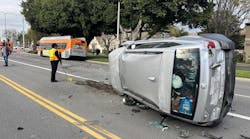Subject: Carbon Fiber
Topic: Carbon Fiber Structural Materials
Objective: Understand the application of carbon fiber in passenger vehicle structures
Task: Given the opportunity to inspect a new vehicle, such as a BMW i3 with carbon fiber materials comprising portions of its structure, the rescue team shall identify the presence of carbon fiber and preplan how the carbon fiber can be managed during a vehicle crash incident.
This University of Extrication column begins our first look at the use of carbon fiber reinforced plastic (CFRP) in passenger vehicle structures. Our objective in Part 1 of this series is to explain what carbon fiber material is and how a responder at a crash scene might be able to identify the presence of carbon fiber on a crash-damaged vehicle.
Carbon fiber has been used in Formula 1 racecars since 1981. Aircraft with carbon fiber structures today include the Airbus 310 and the Boeing 777 and 787. Carbon fiber use in vehicle structures is increasing in passenger vehicles as well. This topic is being researched now because of the use of carbon fiber as a significant portion of the structural members in the new 2015 BMW i3 and i8 electric vehicles. We’ll delve deeper into the specific use of carbon fiber in the structure of these vehicles in future articles on this topic. Initially, let’s begin with identification of carbon fiber on a vehicle.
Examining the McLaren 650S Coupe
To start off our carbon fiber study, we have the opportunity to examine a 2015 model year $307,000 supercar: the McLaren 650S Coupe. This rear-wheel drive vehicle uses a 641-hp engine to attain a top speed of 207 mph. The 0 to 60 time is a mere 2.9 seconds!
Carbon fiber weighs approximately half as much as steel and 30 percent less than aluminum, according to BMW engineers. The carbon fibers are formed into a fabric-like sheet material that is layered together to form the shape of the structural component. The fiber alignment within each layer of carbon fiber is one sign that responders may be able to use when identifying carbon fiber structural components.
Once pre-formed, the shaped pieces have a special resin and a hardening agent injected under extremely high pressure. The component is then cured to form the finished structural piece.
As you can see from image #2, the black passenger compartment is what McLaren refers to as its MonoCell, which is constructed almost entirely of carbon fiber. The front and rear structures added onto this carbon fiber MonoCell are aluminum. Close examination reveals that the huge rockers, instrument panel, floorpan and the short base of the A- and B-pillars are all carbon fiber.
One telltale clue that an observant responder might use to identify the presence of carbon fiber is shown in the close-up view of the McLaren rocker. Because much of the carbon fiber structural components remain unpainted, we see what we might call the “weave” of the carbon fiber layers that make up this structural part. This same weave pattern is visible on the carbon fiber components of the BMW i3 and i8 electric vehicles where it is used in their vehicles.
What’s ahead
Additional columns on this topic will explore carbon fiber reinforced plastic in more depth and will explain the rescue and extrication implications of this material.
Read the rest of the series here:
Part 2: Taking a close look at the BMW i3
Part 3: Working with carbon fiber during crash situations






